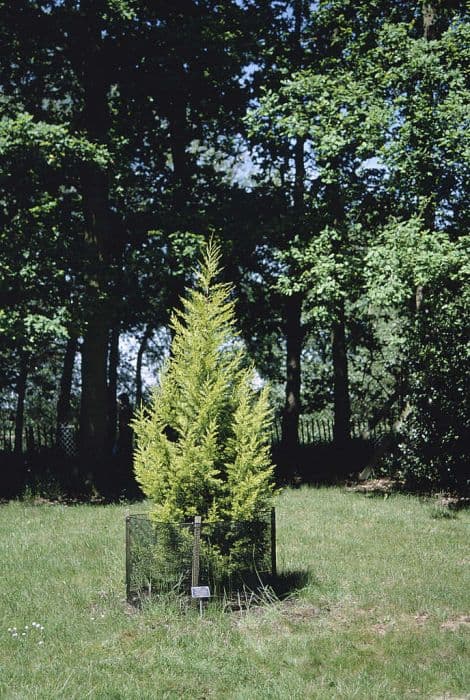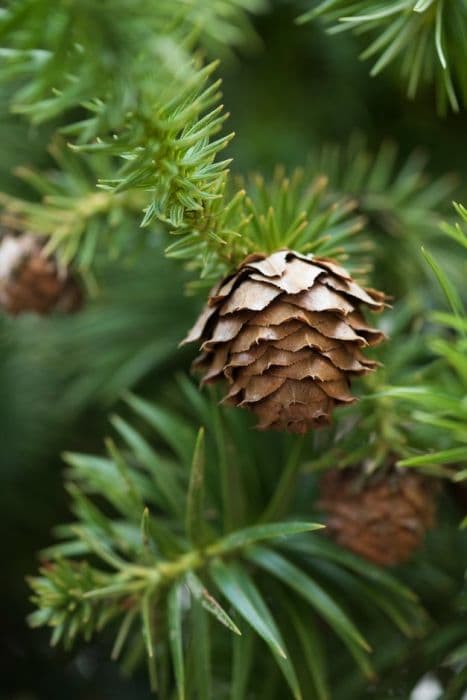Coastal redwood Sequoia sempervirens

ABOUT
S. sempervirens is a fast-growing, very large evergreen tree forming a narrowly conical crown, with fibrous, red-brown bark. Leaves 1-2cm, two-ranked, dark green above, whitish beneath. Cones globose, 2-3cm
About this plant
 Names
NamesFamily
Cupressaceae.
Synonyms
Coast Redwood, California Redwood, Giant Redwood, Coastal Sequoia, Redwood.
Common names
Sequoia sempervirens Endl., Sequoia gigantea Decne., Taxodium sempervirens Lamb., Wellingtonia sempervirens Seem.
 Characteristics
CharacteristicsLife cycle
Perennials
Foliage type
Evergreen
Color of leaves
Green
Height
300 feet [91 meters]
Spread
25 feet [7.6 meters]
Plant type
Tree
Hardiness zones
7
Native area
North America
Benefits
 General Benefits
General Benefits- Carbon Sequestration: The coast redwood is known for capturing significant amounts of carbon, helping to mitigate the impacts of climate change.
- Longevity: As one of the world’s longest-living trees, coast redwoods provide stable ecosystems for extended periods.
- Biodiversity Support: Coast redwoods create unique habitats that support diverse species of plants and animals.
- Erosion Control: Their extensive root systems stabilize the soil, reducing erosion and benefiting the landscape.
- Recreational Value: Coast redwoods attract visitors for hiking, camping, and education, providing economic benefits through ecotourism.
- Educational Resource: They serve as a natural laboratory for scientists and students to study ecology and conservation.
- Climate Regulation: The extensive forests of coast redwoods play a role in the regulation of local climates by moderating temperatures and maintaining high humidity levels.
- Water Cycle Contribution: They play an integral part in their ecosystems' water cycles by intercepting fog and rain.
- Aesthetic Value: Coast redwoods have significant aesthetic value due to their grandeur and majestic presence.
- Cultural Significance: They have been important to indigenous cultures and hold a special place in the cultural heritage of the regions where they grow.
 Medical Properties
Medical Properties- This plant is not used for medical purposes.
 Air-purifying Qualities
Air-purifying QualitiesThis plant is not specifically known for air purifying qualities.
 Other Uses
Other Uses- Canoe Construction: Coastal Redwood bark and trunks have been fashioned into canoes by indigenous peoples owing to the wood's buoyancy and resistance to decay.
- Photography Subjects: Due to their massive size and grandeur, Coastal Redwoods are often sought after by photographers for nature and landscape photography.
- Insect Habitat: The thick bark of the Coastal Redwood provides a habitat for a myriad of insects, contributing to biodiversity and ecosystem health.
- Musical Instruments: The resonance of the Coastal Redwood's wood makes it a valuable material for crafting soundboards for stringed instruments.
- Bonsai: Some enthusiasts use Coastal Redwood to create bonsai trees, manipulating them to grow in miniature form.
- Carbon Sequestration Demonstrations: These trees are sometimes used in educational settings to demonstrate the process of carbon sequestration due to their impressive growth rate and size.
- Playground Equipment: Because of its durability and resistance to rot, Coastal Redwood is often used in outdoor playground constructions.
- Landscape Gardening: Young Coastal Redwoods are sometimes planted in gardens and parks for their aesthetic appeal and to create shaded areas.
- Wildlife Refuge: The Coastal Redwood forest ecosystem provides refuge and nesting sites for endangered species such as the Spotted Owl.
- Furniture Making: The wood from Coastal Redwoods is sometimes used to make high-quality outdoor furniture due to its weather resistance and longevity.
Interesting Facts
 Feng Shui
Feng ShuiThe Redwood is not used in Feng Shui practice.
 Zodiac Sign Compitability
Zodiac Sign CompitabilityThe Redwood is not used in astrology practice.
 Plant Symbolism
Plant Symbolism- Longevity: The most common name of Sequoia sempervirens is the Coastal Redwood. These trees can live for thousands of years, making them a symbol of enduring longevity and timelessness.
- Strength: Coastal Redwoods have a robust structure and can withstand many natural challenges over centuries. Their strength makes them a symbol of resilience and stability.
- Growth: As one of the tallest tree species in the world, the Coastal Redwood is associated with continual growth, both physically and metaphorically.
- Protection: These trees create an ecosystem that shelters numerous plants and animals, symbolizing protection and a nurturing presence.
- Wisdom: The age and majestic stature of Coastal Redwoods are often equated with wisdom, reflecting accumulated knowledge over long periods.
 Water
WaterThe California redwood, or coast redwood, prefers to be kept in moist soil and requires regular watering. Water deeply once a week, providing about 1.5 to 2 gallons per inch of trunk diameter at chest height. During dry periods or in particularly hot climates, increase watering to twice per week. Always check the soil moisture level to prevent overwatering, as the root system of a redwood does not like to sit in waterlogged soil. Reduce the amount of water in the winter when the tree is dormant, but do not let the soil dry out completely.
 Light
LightThe California redwood thrives in full sun to partial shade conditions. It prefers a spot where it can receive several hours of direct sunlight each day, but it can also tolerate light, dappled shade. Ensure that the tree has enough open space to accommodate its eventual large size without being shaded by other larger trees or structures.
 Temperature
TemperatureThe California redwood can survive in temperatures ranging from 20 to 95 degrees Fahrenheit (-6 to 35 degrees Celsius), but it grows best when temperatures are consistently between 60 and 75 degrees Fahrenheit (15 to 24 degrees Celsius). It is hardy and can endure occasional dips below this range, but it should be protected from extreme cold or frost for prolonged periods.
 Pruning
PruningPruning the California redwood is generally for removing dead or broken branches and shaping young trees. Prune in late winter or early spring before new growth starts. Remove crossing branches or any that compromise the tree's structure. Avoid heavy pruning, as redwoods heal slowly from large wounds. Be cautious with the timing and technique to prevent unnecessary stress to the tree.
 Cleaning
CleaningNot needed
 Soil
SoilThe best soil mix for the Coast Redwood (Sequoia sempervirens) should be well-draining, rich in organic matter, and slightly acidic to neutral, with a pH range of 5.5 to 7.0. A mixture of two parts loam, one part sand, and one part compost can provide the necessary conditions for healthy growth.
 Repotting
RepottingThe Coast Redwood (Sequoia sempervirens) is typically a large landscape tree and doesn't require potting in a traditional sense. In a container, young trees should be repotted every 2-3 years until they are planted outside.
 Humidity & Misting
Humidity & MistingCoast Redwood (Sequoia sempervirens) thrives in high humidity environments, ideally above 50%. In their natural habitat, they benefit from the frequent coastal fog which helps maintain the necessary humidity levels for optimal growth.
 Suitable locations
Suitable locationsIndoor
Not suitable to grow indoors, requires large space, direct sunlight.
Outdoor
Plant in moist, well-drained soil; full sun to partial shade.
Hardiness zone
7-9 USDA
 Life cycle
Life cycleThe life of a Coast Redwood (Sequoia sempervirens) begins with the germination of seeds, which typically occurs in the moist soil of a shaded forest floor. Following germination, a seedling grows, relying on nutrients from the soil and photosynthesis to develop a strong root system and a tall, slender stem. As a sapling, the Coast Redwood enters a rapid growth phase, which it maintains for several hundred years, eventually reaching up to 300 feet or more in height. Throughout its maturity, the tree reproduces by producing cones that release seeds and also by sprouting new trees from its roots or basal burls. Mature trees can live for over 2,000 years, continuing to reproduce and contribute to the forest canopy. Eventually, when the Coast Redwood dies, it decomposes and enriches the forest soil, completing its life cycle and supporting the growth of new plants in its ecosystem.
 Propogation
PropogationPropogation time
Spring to Summer
The Coast Redwood (Sequoia sempervirens) is commonly propagated through semi-hardwood cuttings. This technique typically occurs during the fall season when the tree's growth has slowed. The process involves selecting healthy shoots from the current or past year's growth, each about 6 to 8 inches (15 to 20 centimeters) in length. These cuttings should have a few sets of needles and be cut at a 45-degree angle just below a node. It's crucial to treat the cut end with rooting hormone to encourage root development and plant the cutting in a well-draining rooting medium kept moist but not soggy. The cuttings require a high humidity environment, which can be maintained by a humidity dome or a makeshift plastic covering. With the right conditions, roots can develop within a few months, after which the young plants can be transferred to a more permanent location.









